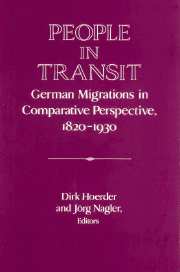Book contents
- Frontmatter
- Introduction
- PART I CONTINUITY AND COMPLEXITY: MIGRATIONS FROM EAST ELBIAN GERMANY AND GALICIAN POLAND
- Part II Internal German Migrations and In-Migrations
- 6 Traveling Workers and the German Labor Movement
- 7 Migration in Duisburg, 1821-1914
- 8 In-Migration and Out-Migration in an Area of Heavy Industry: The Case of Georgsmarienhütte, 1856-1870
- 9 Foreign Workers in and around Bremen, 1884-1918
- PART III WOMEN'S MIGRATION: LABOR AND MARRIAGE MARKETS
- PART IV ACCULTURATION IN AND RETURN FROM THE UNITED STATES
- 18 Migration Past and Present - The German Experience
- 19 Research on the German Migrations, 1820s to 1930s: A Report on the State of German Scholarship
- Index
8 - In-Migration and Out-Migration in an Area of Heavy Industry: The Case of Georgsmarienhütte, 1856-1870
Published online by Cambridge University Press: 05 January 2013
- Frontmatter
- Introduction
- PART I CONTINUITY AND COMPLEXITY: MIGRATIONS FROM EAST ELBIAN GERMANY AND GALICIAN POLAND
- Part II Internal German Migrations and In-Migrations
- 6 Traveling Workers and the German Labor Movement
- 7 Migration in Duisburg, 1821-1914
- 8 In-Migration and Out-Migration in an Area of Heavy Industry: The Case of Georgsmarienhütte, 1856-1870
- 9 Foreign Workers in and around Bremen, 1884-1918
- PART III WOMEN'S MIGRATION: LABOR AND MARRIAGE MARKETS
- PART IV ACCULTURATION IN AND RETURN FROM THE UNITED STATES
- 18 Migration Past and Present - The German Experience
- 19 Research on the German Migrations, 1820s to 1930s: A Report on the State of German Scholarship
- Index
Summary
The town of Georgsmarienhütte, in what is now western Lower Saxony, is a relatively young industrial community. It was incorporated in 1860 as the result of the establishment of the Georgs-Marien Mining and Foundry Company (Georgs-Marien-Bergwerks- und Hüttenverein, or GMBHV) in 1856. Like many new companies of the period, the GMBHV was based on coal and iron ore; in 1871 the company had about 1,500 employees and the town's population was 1,590. After World War I the GMBHV became part of the Klockner concern, one of the largest mining and steel companies in Germany. The number of employees steadily increased through midcentury, reaching a peak of about 6,000 in the 1960s. Today, only about 2,000 people work at the Georgsmarienhütte facility.
In the sense that the object of study can be clearly isolated and defined, Georgsmarienhütte represents a kind of laboratory for the historian. The plans for the Georgsmarienhütte factory were drawn up in the distant state capital of Hanover, as were the architectural plans for the village. Practically all of the employees who lived and worked in Georgsmarienhütte had migrated and settled there at the time the factory was built. And because the community always remained an industrialized island in the midst of an agrarian region, Georgsmarienhütte's isolation was even more complete. These conditions allow us to make unusually clear assumptions in preparing to study Georgsmarienhütte as a community and an industrial site.
- Type
- Chapter
- Information
- People in TransitGerman Migrations in Comparative Perspective, 1820–1930, pp. 177 - 200Publisher: Cambridge University PressPrint publication year: 1995
- 1
- Cited by



